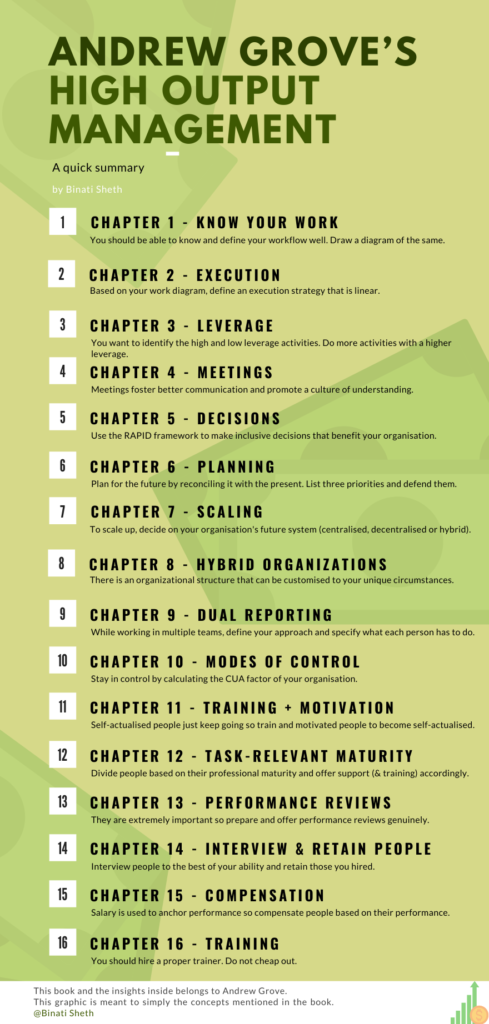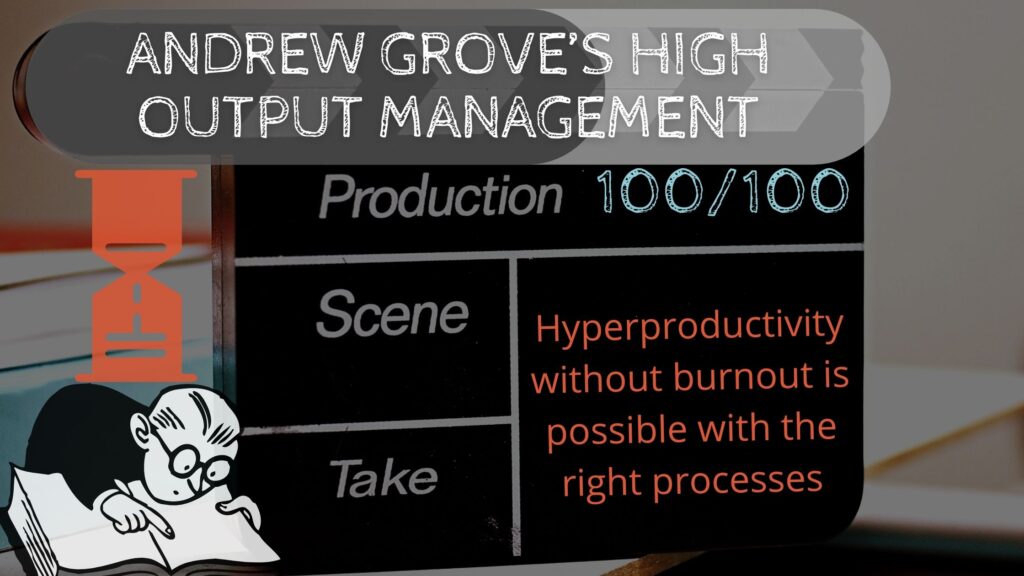Andrew Grove’s High output Management is not a book; it is more of a textbook. So a disclaimer on my part, read the book as if it is a textbook. Another disclaimer will have to be this: while the book will benefit managers and industry leaders the most, freelancers and entrepreneurs can also employ the input-output strategy Mr. Grove recommends.
Andrew Grove’s High output Management is not a book; it is more of a textbook. So a disclaimer on my part, read the book as if it is a textbook. Another disclaimer will have to be this: while the book will benefit managers and industry leaders the most, freelancers and entrepreneurs can also employ the input-output strategy Mr. Grove recommends.
The book offers Experience + Knowledge + Learning + Unlearning.
The three main things you learn:
- Every single person within an organisation has some output (which can be optimised).
- Managers are like micro-CEOs. Their overall output is equal to the team’s output (leverage the output).
- Everyone should chase peak performance (and how a manager’s peak performance inspires the team’s peak performance).
He also goes into the communication system employed by Intel Corp (when he was in charge of it).
If you want to read Andrew Grove’s High output Management, you can:
- Visit your local library.
- Borrow the book from a friend.
- Grab a free audiobook from audible (which gives one book for free once you sign up).
- Buy the book from a local bookshop (support small businesses).
- Buy the book from Amazon.
Now, let us get into the book summary of Andrew Grove’s High output Management, shall we?
The specifics:
The Chapter-wise breakdown:
Part I – The Breakfast Factory
Chapter 1: The Basics of Production: Delivering a Breakfast (or a College Graduate, or a Compiler, or a Convicted Criminal)
Know your work
An employee should know their own work. They should know what their own output is. This is where you draw your entire workflow with an expected output and an actual output. If you can make this diagram easily, chances are your workflow is optimised to suit you. If not, know your work well.
Chapter 2: Managing the Breakfast Factory
Execution
Understand with clarity who you are and what you do without all the weasel language. Weasel language is the language you use to justify things unnecessarily. Then, make an execution strategy. Begin by identifying the indicators in your group output. See the quality and quantity of output. Notice your most important indicators regularly and set goals accordingly. Keep doing this and you’ll be able to predict your job performance. Keep simplifying your workflow (make it as linear as possible) as you do this activity repeatedly.
Part II – Management Is A Team Game
Chapter 3: Managerial Leverage
Leverage
Time is the most valued asset. Individual contributions generally have a low leverage. Activities like coaching and teaching have high leverage. Ideally, you want to increase high leverage activities. Make a plan accordingly.
Chapter 4: Meetings—The Medium of Managerial Work
Meetings
No matter how much we hate them, meetings are important. Mostly upper management needs meetings to see how stuff tends to work on the floor. Lower management needs them to gauge their understanding of the work. Depending on the type of the meeting, you have to have a set mind frame.
Chapter 5: Decisions, Decisions
Decisions
You should make decisions with all the information. To have all the information, have free discussion, then go to clear decisions (people won’t be on the same page), finally have full support discussions (to enhance inclusion). Make these decision-based discussions a loop. Communication skills come in play massively here.
While making decisions, remember to prioritise the deadlines. Mention all the people to be included in a decision (who decides, who consults, who’ll be informed, who can override, who can make authority-based changes).
Also, try the RAPID framework for decision making:
Input + Recommend + Agree + Decide = Decision

While doing all of this, remember that making decisions is hard. So, give people some space.
Chapter 6: Planning: Today’s Actions for Tomorrow’s Output
Planning
You have to ask yourself this question: What should you do today, to avoid problems tomorrow? Based on your answer, you should analyse and evaluate your present while focusing on your organisational capacity. Then you should think about the future and maybe forecast things. Finally, reconcile the present with the future.
Make a plan. Strategize and execute according to that plan because existing resources will be utilised by the activities of the present and therefore they might dominate the decision-making process.
Also, Mr. Grove recommends this: define three important tasks for your organisation and defend them with proper discussions.
Part III – Team Of Teams
Chapter 7: The Breakfast Factory Goes National
Scaling
Every business plans to scale up. If you are someone with a product and a team, you can scale up. Before you try scaling, you have to have the centralisation versus decentralisation discussion. Then, you need to plan. Finally, set your system and expectations, and begin scaling.
Chapter 8: Hybrid Organisations
Centralised versus Decentralised versus the Best of Both Worlds
You have three choices. See your organisation structure and reorganise accordingly. They are:
- Decentralised systems: They offer fast execution of tasks which enable super quick decisions. Resources can be used easily. Each individual is independent of the organisation. All of this can make these structures expensive. Given their flexible nature, an employee can explore employment options throughout the entire organisation.
- Centralised systems: They offer high specialisation, expertise and leverage. On account of the expertise involved, lengthy negotiations are a common phenomenon making these systems slow to respond.
- Hybrid systems: You analyse your organisation. You mix and match the aspects of centralisation and decentralisation.
Chapter 9: Dual Reporting
This phenomenon shows up the larger the company is. When dual reporting presents itself, you can go:
- Function oriented (focus of the execution; the how)
- Mission oriented (focus on the project)
No matter what approach you follow, remember to work with the problem solvers. Flexibility will be key, followed closely by communication. As you are working with multiple teams, clarify what is expected from everyone you’re working with.
Chapter 10: Modes of Control
There are three modes of control that tend to affect an organisation. They are:
- Free market forces (based on personal choices)
- Contractual obligations (the law)
- Cultural values (what makes us human)
Mr. Grove further classifies these into VUCA which is volatility, uncertainty, ambiguity, complexity. As volatility is something we cannot control, all you can do is calculate your organisation’s CUA factor to stay in control.

He stresses upon remembering how you need cultural values to make your organisation adjust to change. Cultural values also enable you to improve people’s trust.
Part IV – The Players
Chapter 11: The Sports Analogy
Training + Motivation
Super athletes are highly motivated to perform irrespective of the circumstances. To have employees who are self actualised, you have to provide them with proper training and motivation. You have to find gaps in everyone’s situation and address them by proper training or coaching.
Also, remember that once someone achieves what they set out to do, their motivation will drop. To avoid that, find out what keeps their motor running. Self-actualised people just keep going.
Chapter 12: Task-Relevant Maturity
It is shortened to TRM. There are four steps to maturity:
- Directing
- Coaching
- Supporting
- Delegating
Everyone is different so try task relevant maturity. For people with low TRM, offer full support. Most individuals will have medium TRM. Observe where they need support and provide it. Very few individuals within each organisation have high TRM. Offer minimal support to these highly actualised people but you need to closely monitor them.
Chapter 13: Performance Appraisal: Manager as Judge and Jury
Performance Reviews
Performance reviews are super important.
When you offer performance reviews, avoid these:
- Any surprises.
- Not giving any improvement suggestions.
- Sending mixed messages.
- Feedback which is too general.
- Only commenting on recent work.
When you offer performance reviews, definitely practice these:
- Be honest with praise and criticism.
- Prepare in advance.
- Watch your body language and observe their body language (adjust your response accordingly).
- Check whether the message is heard.
- Focus on suggestions.
Andrew Grove tells us to focus on the star performers by giving them the most comprehensive performance reviews.
Chapter 14: Two Difficult Tasks
Interviewing and retaining people
Interviewing people is hard. Even if someone aces all the aspects of an interview like:
- Skill questions
- Achievements/failures
- Strengths/Weaknesses
- What values should we hire you for
… this employee can fail. To avoid falling into this trap, check for skill gaps. See what they did with their knowledge. Notice any of the discrepancies to see how they learned from past mistakes.
Retaining employees is also important. To retain good employees, collaborate with the supervisor. If someone says, ‘I quit’, that is a bad indicator. This will cause a cascading effect of resignations.
Chapter 15: Compensation as Task-Relevant Feedback
Salary
Salary is used to anchor performance. You need to compensate your employees accordingly.
Chapter 16: Why Training Is the Boss’s Job
Training
You should hire a proper trainer. Do not cheap out.
This is a wrap on Andrew Grove’s High output Management. You should definitely read this book.
If you want to read more summaries, check out the book summary section.
Happy Reading!
While you’re at it, subscribe to the monthly newsletter.
The Writing Catalogue
Ideas, Words, Bestsellers
Did you enjoy Andrew Grove’s High output Management?





